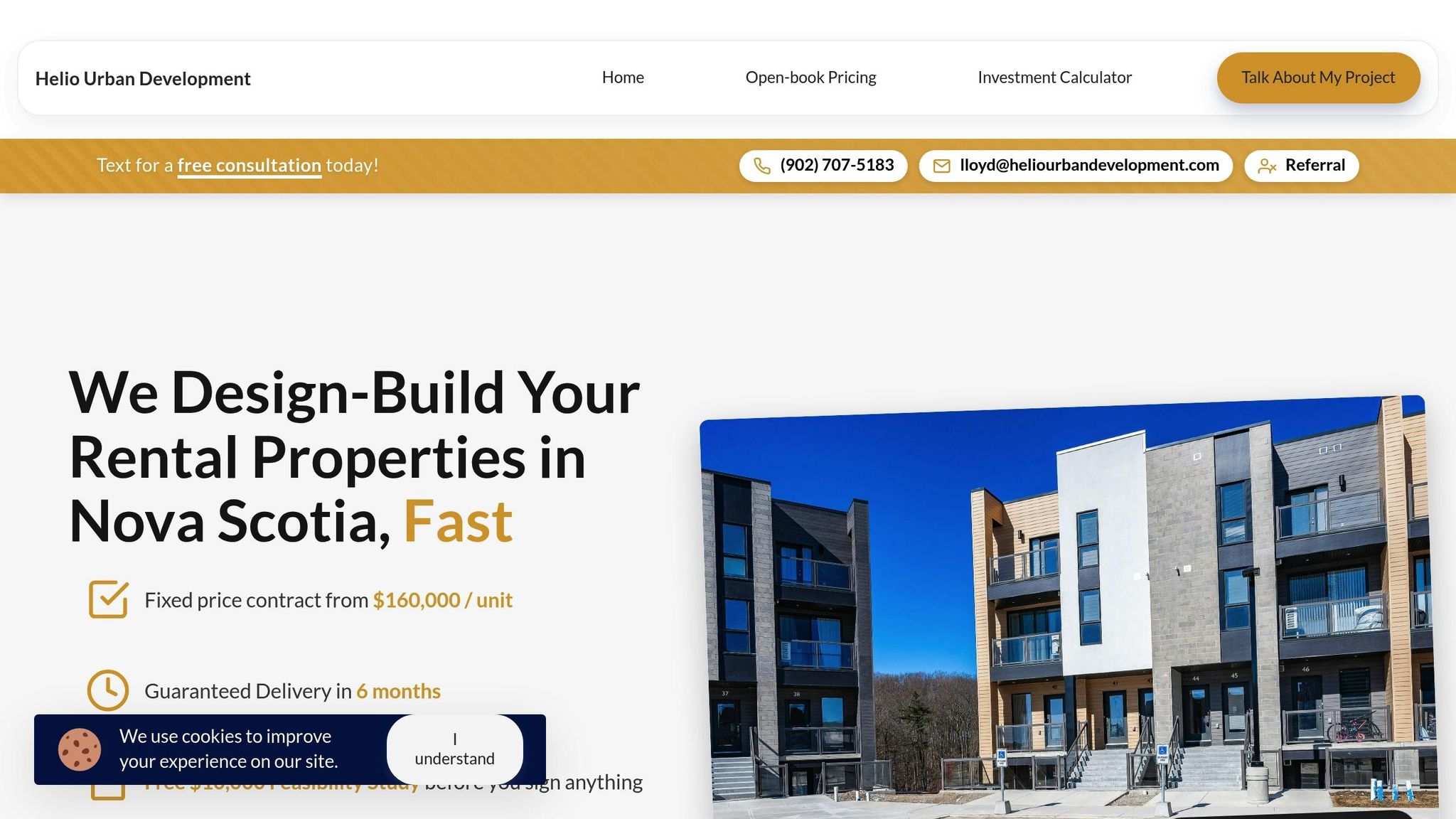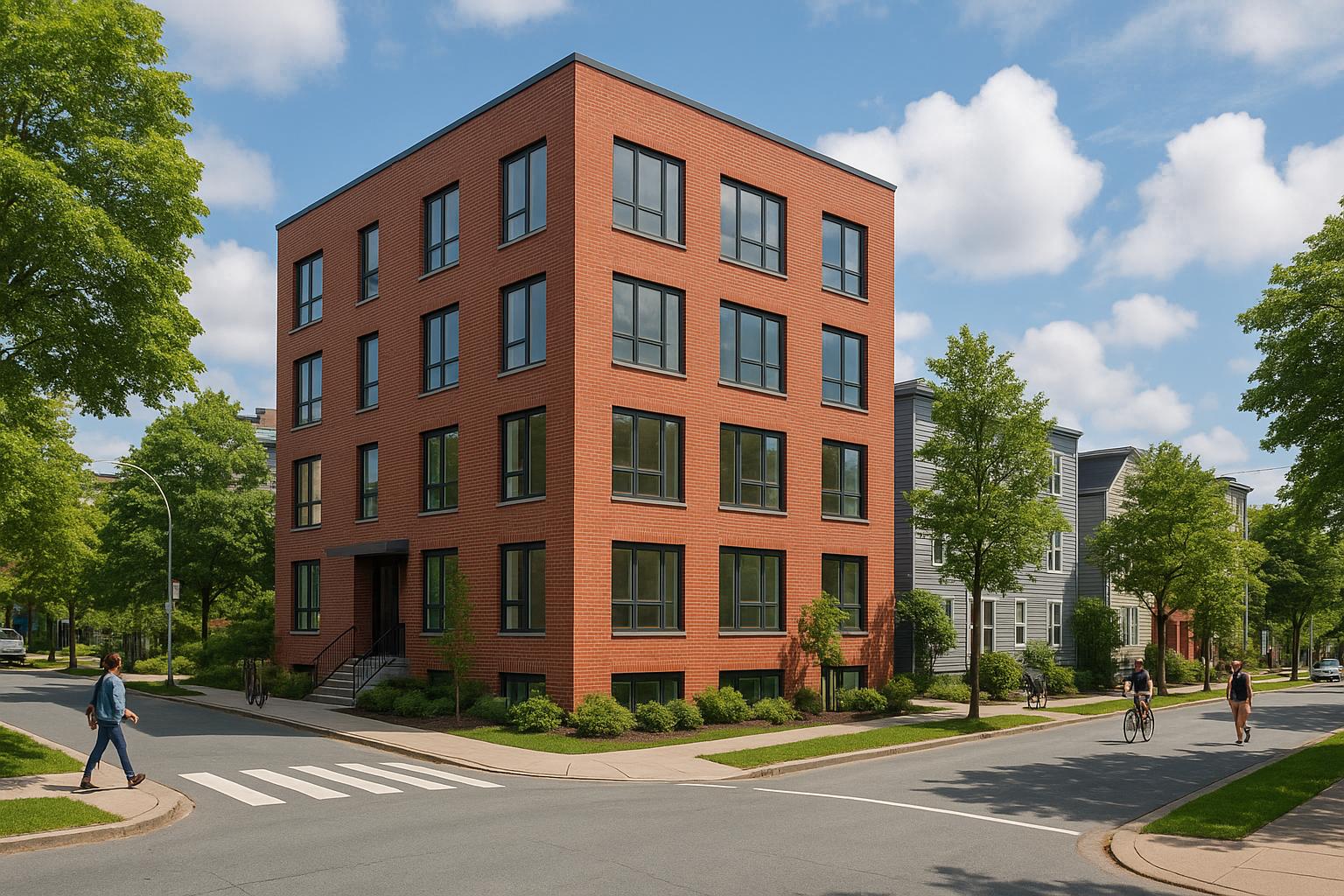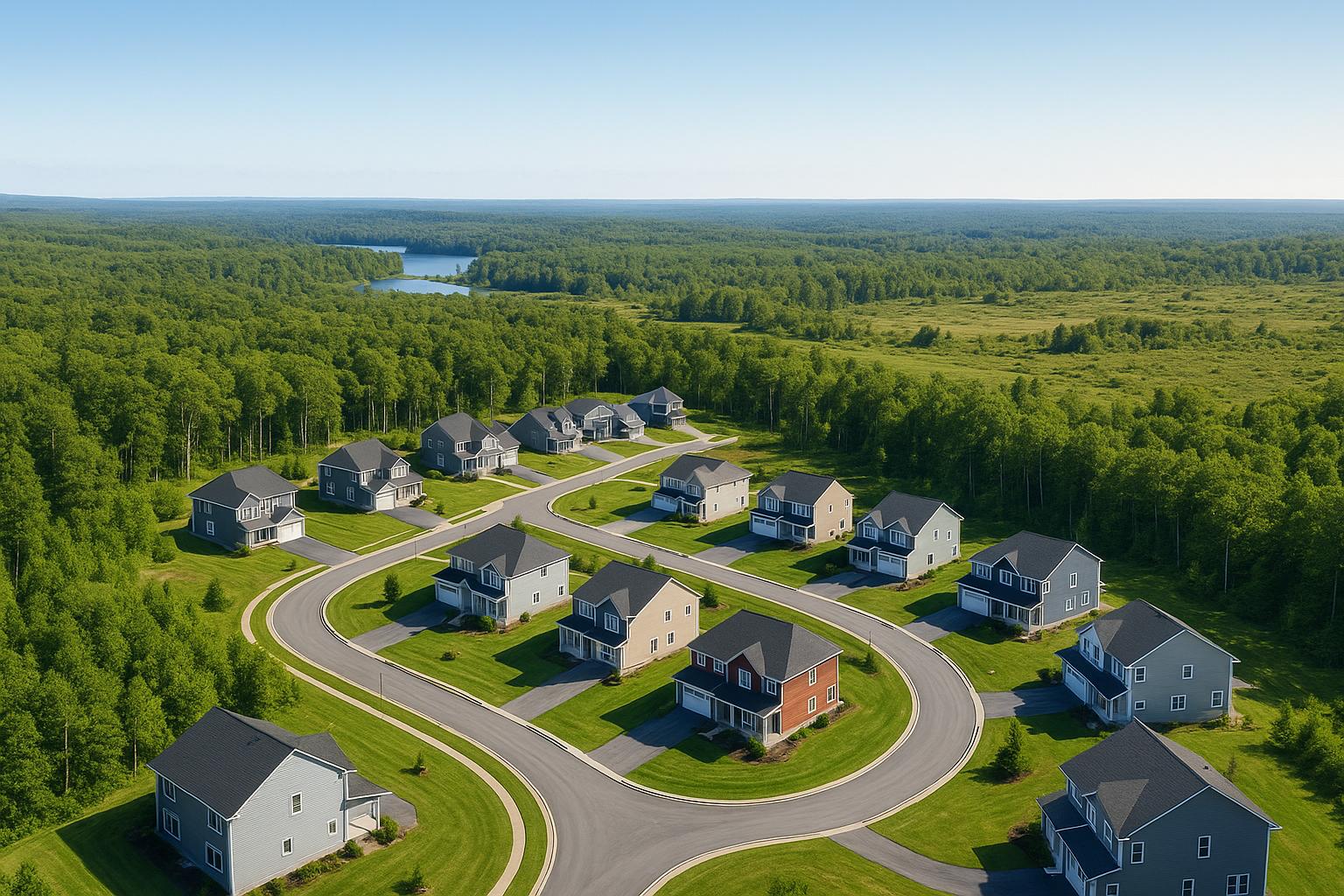Want to make your Halifax multi-unit property fit in? Start by focusing on three key design elements: materials, rhythm, and entryways. These ensure your building complements the neighbourhood while meeting Halifax's design rules.
- Materials: Use wood, brick, or stone to reflect local architecture, blending traditional and modern styles.
- Rhythm: Align window and facade patterns with nearby buildings to maintain visual flow.
- Entryways: Design entrances that are practical, inviting, and scaled to the area, incorporating features like covered porches, proper lighting, and accessible pathways.
Halifax's "Red Book" guidelines and integrated design-build methods can help streamline the process, ensuring your project respects neighbourhood character while staying on budget. Done right, your property can enhance the streetscape and deliver impressive ROI.
Blending Design and Purpose: Omar Gandhi's North End Home with Custom Wood Interiors & Cedar Veil
Selecting Facade Materials That Match Halifax's Architecture
The exterior materials you choose play a big role in reflecting Halifax's architectural heritage. In the South End, wood siding is a common sight, showcasing the area's history of using locally available timber and traditional building techniques. Meanwhile, downtown Halifax often features brick facades for residential buildings, while civic structures highlight the sturdiness of sandstone and granite. This thoughtful use of materials helps create a consistent and visually appealing streetscape.
Choosing the right facade materials is essential to maintaining a unified look that complements the character of the neighbourhood. It's about balancing respect for local heritage with modern functionality. To do this, consider which materials are most prominent in your area and think about how they can be blended into a contemporary multi-unit design.
Mixing Traditional and Modern Materials
Wood is a hallmark of Halifax's residential architecture, appearing across a variety of historical styles [2]. For multi-unit properties, wood siding often works well as the main material, offering a warm and familiar aesthetic. Brick, on the other hand, can be used strategically to provide durability and visual impact, such as on ground floors or accent walls.
Incorporating cast iron details can also add a touch of classic charm to your design [1]. These elements not only enhance the facade but also nod to Halifax's architectural traditions.
When selecting materials, it’s important to ensure they align with municipal guidelines to blend seamlessly with the surrounding area.
Following Halifax Regional Municipality Design Rules

Halifax Regional Municipality’s "Red Book" offers a set of design guidelines [3]. While these guidelines focus on infrastructure elements like streets, drainage, lighting, and street trees, they don’t explicitly dictate facade materials for buildings [3]. However, they provide a framework for creating streetscapes that are cohesive and functional.
Property owners need to navigate these guidelines alongside other requirements from local authorities [3]. The "Part A: Design Guidelines" and "Part B: Standard Details" documents serve as a starting point for understanding what’s expected. Although they don’t specify facade materials for multi-unit rental properties, they help establish broader streetscape goals.
If your property is located in a heritage district or an older neighbourhood, additional design review processes may apply. These reviews often focus on ensuring that material choices are compatible with the surrounding built environment. Understanding these regulatory layers early in your project can help you make informed decisions that meet both aesthetic and performance needs.
Creating Architectural Rhythm That Fits the Neighbourhood
When designing a building that reflects local heritage, it’s not just about choosing the right facade materials. The rhythm of the architecture also needs to align with the surrounding neighbourhood. Architectural rhythm ties your multi-unit development to its environment by incorporating the design patterns and features that define the area. The key is to identify the underlying patterns in nearby buildings rather than mimicking every detail.
Understanding how buildings interact and relate to one another is crucial. It’s about recognizing the recurring elements that give the street its unique character.
What Architectural Rhythm Means
Architectural rhythm refers to the intentional repetition and variation of design elements to create a sense of unity. These elements combine to establish a consistent visual flow across the streetscape.
To identify these elements, property owners can observe the common materials, architectural styles, and even how these materials have aged in the neighbourhood. This attention to detail helps create a design that feels like a natural part of the area.
Matching Design Elements with Adjacent Buildings
To ensure your property blends seamlessly with its surroundings, take cues from the defining characteristics of nearby buildings. Look at the overall design language of the neighbourhood and incorporate those elements into your project. This approach allows your development to connect visually with the streetscape, reinforcing the neighbourhood’s established identity.
The goal isn’t to replicate neighbouring structures but to create visual relationships that contribute to a unified streetscape. By balancing modern design with the existing architectural cues, you can achieve a design that feels integrated. This rhythm also sets the stage for designing entryways that further enhance the connection to the surrounding streetscape.
Building Entryways That Work Well and Look Good
The entryway is the first impression of your multi-unit property, acting as both a welcome point and a bridge between your building and the streetscape. A thoughtfully designed entrance does more than just greet residents and visitors - it reflects the overall design vision and respects the character of the neighbourhood. Striking the right balance between functionality and aesthetics is key.
To create an effective entryway, it’s important to consider how people will actually use the space. Residents, visitors, and emergency services all need quick, clear, and unobstructed access. These practical needs should align seamlessly with the visual language of your building, shaped by your choice of materials and architectural rhythm. Once these basics are in place, you can focus on refining the details that make the entryway both functional and beautiful.
Must-Have Features for Good Entryway Design
- Clear wayfinding: Ensure unit numbers are easy to spot, properly sized, and visible in both natural light and at night with appropriate illumination.
- Weather protection: Include a covered entryway extending at least 1.2 metres to shield from rain and snow, creating a smooth transition from public to private space.
- Proper lighting: Use wall-mounted fixtures to enhance security, highlight architectural details, and provide inviting, even illumination without harsh glare.
- Accessibility features: Incorporate gentle slopes, user-friendly door hardware, and adaptable entry systems to ensure the space is usable by everyone while maintaining design integrity.
- Package management: Add secure package lockers or similar systems to handle deliveries efficiently without detracting from the overall aesthetic.
Making Entryways Match Your Building Style
Once the functional aspects are covered, the entryway should seamlessly reflect the building’s style. This means continuing the materials, proportions, and detailing that define the facade. For example, if your building features brick and wood accents, those same materials should appear in the entryway in a way that feels natural and cohesive.
Scale relationships are critical. The size and prominence of the entrance should match both the building’s character and the surrounding neighbourhood. A small, four-unit residential building requires a simpler, more understated entry than a large development on a bustling commercial street. The goal is to create an entrance that is noticeable and welcoming without overpowering the building’s overall design.
Material transitions can add subtle visual interest while maintaining consistency. For instance, you could use the same stone as the building’s base but with a different texture or finish, or integrate wood elements that tie into window trim details. These small variations enrich the design without disrupting its flow.
Colour coordination goes beyond materials to consider how the entryway fits within the broader streetscape. If your building uses darker tones to complement nearby historic structures, the entryway should align with this palette rather than introducing clashing colours. This doesn’t mean everything has to match perfectly, but the colours should work together to enhance the visual harmony of the neighbourhood.
Architectural details from the main facade should also influence the entryway. For example, if the building features distinctive window proportions or unique roofline elements, these themes could be echoed in the entry canopy, door design, or surrounding features. Repeating these design elements creates a sense of unity that makes the building feel naturally integrated into its environment.
The best entryways feel effortless - they meet practical needs while blending seamlessly with the building’s design. Achieving this harmony requires careful consideration of both function and form. When done well, practical elements like lighting, signage, and weather protection enhance the architectural vision rather than detract from it, creating an entryway that feels like a natural extension of the building and its streetscape.
sbb-itb-16b8a48
Halifax Projects That Got Streetscape Integration Right
Halifax offers some great examples of how thoughtful design can help buildings blend seamlessly with their surroundings. By focusing on material selection, rhythm, and functional entry design, several multi-unit residential projects in the city showcase how to integrate modern buildings into established neighbourhoods. The key? Balancing the local vibe with contemporary needs.
The best projects take the time to study their surroundings, choosing materials that complement nearby structures and designing entrances that feel inviting without being over the top.
Project Examples and Lessons Learned
The Argyle and Grafton Street Area is home to several standout projects that respect Halifax's historic downtown. Many of these four- to eight-unit buildings use brick as a primary material, reflecting the area’s masonry tradition. At the same time, they introduce modern window proportions that feel fresh but not out of place.
One building on Grafton Street, for instance, features red brick similar to nearby heritage buildings but adds charcoal metal accents around the windows and roofline. This subtle contrast keeps the design interesting while maintaining the street's cohesive look. The building’s layout also respects the neighbourhood’s narrow lot pattern, with distinct entryways for each unit at street level. This approach blends density with the fine-grained character that defines the area.
Spring Garden Road developments face a different challenge: blending into a mix of commercial and residential buildings from various eras. One notable project uses limestone-coloured concrete panels on the ground floor to harmonize with the commercial streetscape, while wood siding on the upper levels ties into the residential feel of adjacent streets.
The entry design of this Spring Garden project is particularly clever. Instead of a single large entrance, the building features multiple smaller doorways, breaking up its scale and adding a human touch. Each doorway is deep-set with integrated lighting, offering security without harsh glare. The wooden canopies, matching the upper floors, create a seamless connection between materials and make the entrances feel intentional rather than tacked on.
North End Halifax provides a unique opportunity to merge the area’s industrial roots with its growing residential identity. Successful projects here often incorporate darker brick or concrete block, accented with metal details, to reflect the neighbourhood’s history while signalling its transition to residential use.
Near Gottingen Street, a four-unit building shows how simple material choices can fit right in. Its charcoal brick façade echoes nearby industrial structures, while white window trim and red front doors add a welcoming, residential touch. Each unit has its own stoop, encouraging street-level interaction and creating a lively, community-oriented vibe.
The South End’s residential streets demand a different approach. Projects here tend to focus on proportions and scale, using traditional materials like wood siding, brick, or stone, but with modern detailing that feels current without disrupting the neighbourhood’s charm.
One recent South End project uses cedar shingle siding, similar to nearby homes, but arranges it in horizontal bands for a subtle, modern rhythm. The building’s windows align with those of neighbouring houses, respecting the established pattern of the street. Its shared entrance, a simple covered porch, borrows from the area’s typical residential porches but incorporates clean lines and integrated lighting, clearly marking it as a multi-unit building.
These projects succeed because they pay attention to their surroundings, blending modern design with the existing character of their neighbourhoods. The best designs feel like they’ve always belonged, even as they bring something new to the area.
Another crucial factor is material durability. High-quality choices like brick, stone, or premium siding not only look good initially but age well, contributing to the long-term stability of the neighbourhood and protecting property values.
These examples highlight how a thoughtful, integrated design–build process can lead to buildings that fit beautifully into their streetscapes while meeting modern needs.
Using Integrated Construction to Achieve Better Streetscape Fit
Creating a cohesive streetscape requires a construction approach that brings all the pieces together. Unfortunately, traditional methods often lead to disjointed results, with missed details in materials, rhythm, and entry design. When professionals like architects, planners, and contractors work separately, the final product can feel out of sync with its surroundings.
The answer? Integrated design-build. This method brings everyone - architects, planners, engineers, and contractors - into the process from the very beginning. By working as a unified team, they can ensure that streetscape priorities remain a top concern throughout the project. The result is a smoother process and a final product that fits seamlessly into its environment.
Why Integrated Design-Build Outperforms Traditional Methods
Fragmented construction often leads to chaos. Property owners frequently face issues like architects designing without consulting zoning requirements or engineers specifying costly materials that strain the budget. These disconnects can result in budget overruns of 30-60% and stretch project timelines from eight months to over 18 months.
With integrated design-build, these problems are avoided. From the first day, planners, architects, engineers, and contractors collaborate to ensure every decision aligns with streetscape goals.
Take zoning and planning, for example. In a traditional setup, an architect might design a building without verifying zoning setbacks, leading to rejected permits or designs that don’t fit the lot. In an integrated model, planners check zoning compliance right from the start. This ensures that the building’s scale, massing, and setbacks align with the neighbourhood before designs move forward.
Similarly, design and cost coordination benefits from this approach. Under traditional methods, architects create designs first, and costing happens later. This often leads to sticker shock when contractors quote for features like steel beams that weren’t budgeted for. Integrated design-build avoids this by involving engineers and contractors early, allowing for value engineering and material choices that balance budget with aesthetics - key for streetscape integration.
When it comes to permitting, having all disciplines aligned from the outset ensures designs meet Halifax Regional Municipality’s zoning and design rules. This reduces delays and rejections, streamlining the process and keeping projects on track.
How Helio Urban Development Gets It Right

Helio Urban Development is a standout example of integrated construction done well. As Nova Scotia’s only integrated design-build company, Helio combines planners, architects, engineers, and construction teams under one roof. This approach allows them to deliver fixed-price construction at $160,000 per unit in just six months, with penalties of up to $1,000 per day if they miss deadlines.
Their process begins with a free $10,000 feasibility study and 3D visualization. This "See Before You Sign" approach gives property owners a clear view of their project before committing. The study includes a custom development plan and a 3D rendering that shows how the building will look in its neighbourhood, down to the materials and entryways. This early stage visualization is critical for ensuring the design fits the local context and complies with municipal rules.
Helio’s single-contract model guarantees full accountability. Unlike traditional methods where professionals focus only on their specific roles, Helio’s team works collectively to ensure the project’s success, including its streetscape integration. Every design decision is made with the broader neighbourhood in mind.
Currently, Helio has 31 units under construction and 131 more in planning across Nova Scotia, serving property owners within a 90-minute radius of Halifax. Their track record shows that integrated construction can deliver both efficiency and streetscape harmony on a large scale.
Another standout feature of Helio’s approach is daily transparency. Property owners receive photo updates every day, giving them a clear view of how materials are being installed, how the building’s rhythm is developing, and how entryways are shaping up. This level of detail ensures that potential issues are addressed early, preventing them from compromising the final streetscape fit.
For those building fourplexes or larger projects, this integrated approach offers peace of mind. Property owners can focus on their investment goals, knowing their building will enhance the neighbourhood. And the numbers back it up: these projects deliver rents of $1,950–$2,100 per month and 12–20% annual ROI, all while contributing to Halifax’s urban landscape.
Conclusion: Building Better Halifax Streetscapes Through Smart Design
Multi-unit properties can truly enhance Halifax's streetscapes when thoughtful choices in materials, architectural rhythm, and entryway designs complement the surrounding environment. When these elements align, they not only improve a building’s appearance but also maintain the character and harmony of the neighbourhood.
However, even well-designed concepts can fall short during construction. Traditional building methods often struggle to create a seamless streetscape because architects, planners, and contractors typically operate independently. This fragmented approach can result in buildings that feel out of place, along with budget overruns and delays.
Integrated design-build construction provides a more effective solution. Unlike traditional methods, this approach brings all professionals together from the start, ensuring that streetscape considerations remain a priority throughout the project.
A great example of this is the success seen with integrated design-build practices led by industry experts. Property owners who choose this method gain more than just streamlined processes - they achieve buildings that blend seamlessly into their surroundings. Every decision, from facade materials to entryway placement, is made with the neighbourhood in mind. The outcome? Rental properties commanding $1,950–$2,100 per month while contributing positively to Halifax's growing urban identity. This cohesive approach ensures that every detail ties back to the fabric of the city.
Smart design isn’t limited to individual structures - it’s about creating streetscapes that benefit everyone. By coordinating materials, rhythms, and entryways through an integrated process, Halifax can foster neighbourhoods that are not only more attractive and functional but also economically resilient for years to come.
FAQs
How can I design my multi-unit property in Halifax to blend with local heritage while adding modern touches?
To design a structure that honours Halifax's rich architectural history while blending in modern touches, it’s essential to create a sense of balance with the existing streetscape. Begin by delving into the area’s architectural traditions - styles like Gothic Revival or Dutch Colonial can serve as inspiration for your material and design decisions. Choosing facade materials that reflect the neighbourhood’s character is a crucial step in creating a unified and respectful appearance.
For properties located near registered heritage sites, it’s wise to consult Halifax’s heritage guidelines to ensure your design supports conservation efforts. If your plans involve major changes, a heritage development agreement might be necessary to find the right balance between preservation and practicality. Thoughtful details, such as rhythmic facades or inviting entryways, can help your property blend seamlessly with the neighbourhood, all while incorporating a touch of modern design.
What makes an integrated design-build approach better than traditional construction methods for streetscape projects in Halifax?
An integrated design-build approach brings simplicity to the construction process by merging design and construction into a single contract. This means there’s one point of accountability, which helps streamline communication and reduces the chances of delays or miscommunication.
By overlapping the design and construction phases, this method also saves both time and money, cutting out the need for a drawn-out bidding process. For streetscape projects in Halifax, this approach promotes stronger collaboration, speeds up project completion, and delivers a finished product that fits perfectly with the city’s urban landscape.
What should property owners consider when designing entryways that are both functional and visually appealing for multi-unit buildings in Halifax?
When planning entryways for multi-unit properties in Halifax, it's essential to strike a balance between practicality and visual charm. The design should comply with accessibility standards, ensuring it accommodates all residents and visitors. Adding features like well-lit, inviting entrances or ground-floor commercial spaces can also encourage pedestrian interaction and create a lively atmosphere.
Choose materials and architectural details that blend seamlessly with the surrounding streetscape while standing up to Halifax's weather conditions. A thoughtfully crafted entryway not only boosts the property's curb appeal but also fosters a stronger connection to the neighbourhood, making the space feel more welcoming and approachable.
Related Blog Posts
- Top 5 Home Design Trends in Halifax for 2025 (and How to Incorporate Them)
- HR-1 (HR1) Zoning Halifax: 3–6 Storeys and Neighbourhood Transitions
- HR-1 (HR1) Builder Halifax: Stepbacks Next to Houses - Deal-Breaker or Design Move?
- Neighbor‑Friendly Design Moves Under HR‑1: Stepbacks, Entries, and Materials That Calm Concerns



